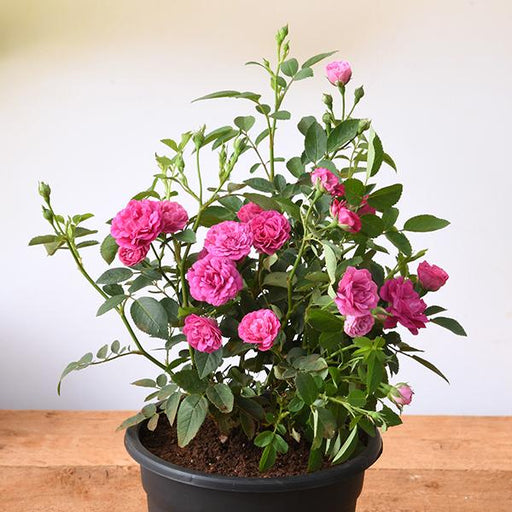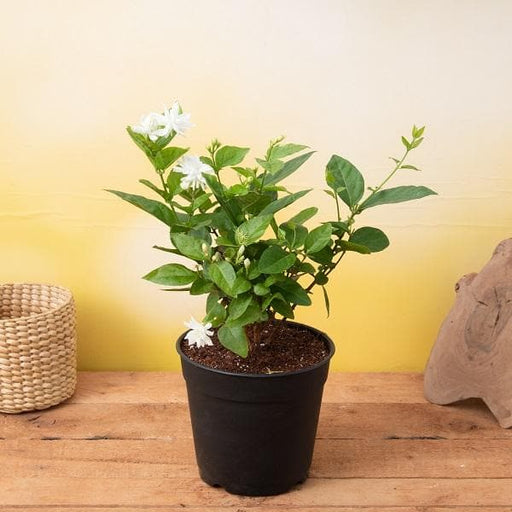
Atropa belladona
(MRP Inclusive of all taxes)
- Shipping ₹79 for entire order
- Dispatch in 7 days
- Country of origin: India

(MRP Inclusive of all taxes)
 Save 29%
Save 29%
Air Purifier Money Plant with Pot The Air Purifier Money Plant, also known as Pothos or Epipremnum aureum, is a stunning indoor plant that...
View full details
 Save up to 15%
Save up to 15%
Peace Lily, Spathiphyllum - Plant The Peace Lily, scientifically known as Spathiphyllum, is a stunning houseplant celebrated for its elegant white...
View full details
 Save 25%
Save 25%
Jasminum sambac, Mogra, Arabian Jasmine - Plant Jasminum sambac, commonly known as Mogra or Arabian Jasmine, is a fragrant flowering plant...
View full details
 Save 18%
Save 18%
Combo Constituents Includes the Parijat Tree (Night-Flowering Jasmine), a culturally significant plant with fragrant flowers. Description The Pari...
View full details
 Save 25%
Save 25%
Miniature Rose, Button Rose (Any Color) - Plant The Miniature Rose, also known as the Button Rose, is a charming and compact flowering plant that ...
View full details Save 25%
Save 25%
Damascus Rose, Scented Rose (Any Color) - Plant The Damascus Rose, also known as Rosa damascena, is a timeless symbol of beauty and romanc...
View full details
 Save 17%
Save 17%
Beautiful Fragrant Mogra, Arabian Jasmine Plant with Pot The Beautiful Fragrant Mogra, also known as Arabian Jasmine (Jasminum sambac), is...
View full details Save 15%
Save 15%
Pack of Vermicompost and Neem Cake for House Plants Transform your indoor garden with our premium Pack of Vermicompost and Neem Cake, spec...
View full details
Pack of Plant Growth and Flower Boosters Unlock the full potential of your garden with our Pack of Plant Growth and Flower Boosters! This ...
View full details Save 38%
Save 38%
Combo of Jeevamrut and Neem Raksha for Easy Growth and Protection of Houseplants Transform your indoor garden with our exclusive combo of ...
View full details Save 22%
Save 22%
Plant Nutrients Kit (Pack of 16) for a Healthy Garden Transform your garden into a lush paradise with our Plant Nutrients Kit, featuring 1...
View full details Save 16%
Save 16%
Combo of Top Plant Fertilizers Elevate your gardening game with our exclusive Combo of Top Plant Fertilizers, featuring two bags of premiu...
View full details Save 24%
Save 24%
Pack of 4 Additives to Make Soil Healthy and Nutrient Rich Transform your garden into a thriving ecosystem with our Pack of 4 Additives de...
View full details Save 30%
Save 30%
Transform your gardening experience with our premium Combo of Perlite and Vermiculite. This unique blend is designed to enhance soil aeration and ...
View full details Save 27%
Save 27%
Combo of 2 Vermicompost and Cocopeat - Enrich Your Soil Naturally! Transform your garden into a thriving ecosystem with our Combo of 2 Ver...
View full details
 Save 35%
Save 35%
Best 6 Plants for Perfect Indoor Garden Transform your living space into a lush oasis with our curated collection of the Best 6 Plants for a...
View full details
 Save up to 50%
Save up to 50%
Mini Succulent Garden Pack Transform your space with our Mini Succulent Garden Pack, featuring a delightful collection of 4 any variety beautiful s...
View full details
 Save 30%
Save 30%
5 Best Fragrant Plants Transform your garden or indoor space into a fragrant paradise with our curated selection of the 5 Best Fragrant Plants. Th...
View full details
 Save 24%
Save 24%
Set of 2 Bonsai Looking Grafted Adeniums Transform your indoor or outdoor space with our exquisite Set of 2 Bonsai Looking Grafted Adenium...
View full details Save 45%
Save 45%
Top 4 Die Hard Succulents Pack Transform your indoor or outdoor space with our Top 4 Die Hard Succulents Pack, featuring a curated selecti...
View full details
 Save 30%
Save 30%
5 Best Indoor Plants Pack Transform your living space into a lush oasis with our '5 Best Indoor Plants Pack.' This carefully curated collection fe...
View full details
 Save 25%
Save 25%
Set of 4 Evergreen Air Purifier Plant Pack Transform your indoor space into a lush, green oasis with our Set of 4 Evergreen Air Purifier Pla...
View full details| SrNo | Item Name |
|---|---|
| 1 | Atropa belladona |
Atropa belladonna, commonly known as belladonna or deadly nightshade, is a perennial herbaceous plant renowned for its striking purple flowers and glossy black berries. Native to Europe, North Africa, and Western Asia, this plant has a rich history in herbal medicine and folklore. While it possesses toxic properties, its alkaloids have been utilized in modern medicine for their anticholinergic effects, making it a fascinating subject of study.
What makes Atropa belladonna special is its dual nature; it is both a beautiful ornamental plant and a potent medicinal herb. Historically, it was used by ancient civilizations for various purposes, including as a cosmetic to dilate pupils, hence the name "belladonna," meaning "beautiful lady" in Italian. Its unique chemical composition, including tropane alkaloids like atropine, scopolamine, and hyoscyamine, contributes to its medicinal value.
One of the special features of Atropa belladonna is its ability to thrive in various environments, from shaded woodlands to disturbed areas. This adaptability, combined with its striking appearance, makes it a captivating addition to any garden. However, caution is advised due to its toxic nature.
Atropa belladonna can have a significant impact on local ecosystems. While it can thrive in disturbed areas, its toxicity poses a risk to wildlife and pets. Care should be taken to manage its growth to prevent it from becoming invasive in certain regions.
Ah, the infamous Atropa belladonna, also known as deadly nightshade! This plant has a reputation that precedes it, often associated with witches and potions. Historically, it has been used for medicinal purposes, from pain relief to dilating pupils (hence the name "belladonna," meaning beautiful lady). However, let’s not forget its darker side; it’s toxic! So, while it may have some uses in herbal medicine, one must tread carefully. Remember, a little knowledge is a dangerous thing, especially when it comes to this enchanting yet perilous plant.
it’s all fun and games until someone ends up in the ER.
Atropa belladonna thrives in shady, moist environments, often found in woodlands and along roadsides. It’s like that introverted friend who prefers the cozy corners of a café over the bustling dance floor. This plant loves to keep it low-key, growing in rich, loamy soil where it can spread its roots without too much fuss. So, if you’re scouting for a spot to plant this beauty, think of a quiet, secluded area where it can flourish without the spotlight. Just don’t forget to keep the kids and pets away!
The history of Atropa belladonna reads like a thrilling novel filled with intrigue, danger, and a sprinkle of witchcraft. Used by ancient civilizations for various purposes, from anesthesia to cosmetics, this plant has been a staple in folklore and medicine alike. The Romans even used it to create a potion for love—talk about a toxic romance! Its historical significance is as rich as its dark reputation, making it a fascinating subject for anyone interested in the intersection of nature and human culture.
Cultivating Atropa belladonna is not for the faint of heart. This plant requires specific conditions to thrive, including well-drained soil and partial shade. It’s like raising a diva; she demands attention and the right environment to flourish. If you’re up for the challenge, you’ll be rewarded with stunning foliage and those infamous berries. Just remember, this isn’t your average houseplant—handle with care, and maybe keep a first-aid kit nearby, just in case you get a little too close for comfort.
While Atropa belladonna is notorious for its toxicity, it also boasts some medicinal properties that have intrigued herbalists for centuries. It contains alkaloids like atropine, which can be used to treat various ailments, from muscle spasms to motion sickness. However, using this plant for medicinal purposes is like playing with fire—exciting but risky! Always consult a professional before diving into the world of herbal remedies, especially with a plant that has such a notorious reputation.
Atropa belladonna has woven itself into the fabric of folklore and mythology, often depicted as a witch’s companion or a potion ingredient. Its enchanting appearance and toxic nature have made it a symbol of mystery and danger. Stories abound of its use in love potions and curses, making it a favorite among storytellers. So, if you’re looking to add a touch of the mystical to your garden, this plant is sure to spark some intriguing conversations—just be prepared for the gasps when you mention its deadly side!
While Atropa belladonna may be toxic to humans, it has its own set of admirers in the animal kingdom. Certain birds and insects have developed a taste for its berries, seemingly unfazed by the plant’s toxic reputation. It’s like the rebellious teenager of the plant world, attracting attention from those who dare to defy the odds. However, for most animals, it’s best to steer clear of this botanical beauty, as it can lead to some rather unpleasant consequences. Nature can be a wild ride!
In the realm of modern medicine, Atropa belladonna has found its niche, particularly in the form of atropine, a compound derived from the plant. This substance is used in various medical applications, including eye exams and as an antidote for certain types of poisoning. It’s a classic case of “don’t judge a book by its cover”—while the plant itself is dangerous, its derivatives have proven invaluable in medical settings. Just remember, this isn’t a DIY project; leave the extraction to the professionals!
it’s not a pet-friendly choice. With its toxic berries and leaves, it’s best suited for gardens that are off-limits to curious critters. Think of it as the exclusive VIP section of your garden—beautiful but not for everyone. Just be sure to label it clearly, so no one accidentally mistakes it for a harmless shrub!
As enchanting as Atropa belladonna is, it faces threats from habitat loss and overharvesting. Conservation efforts are crucial to ensure this plant doesn’t vanish into the annals of history. It’s a reminder that even the most dangerous plants have their place in the ecosystem. So, if you’re passionate about preserving nature’s wonders, consider supporting initiatives that protect this botanical beauty. After all, every plant has a story, and we wouldn’t want to lose the tale of the deadly nightshade!
Atropa belladonna, also known as deadly nightshade, is a perennial herbaceous plant notorious for its toxic properties. With its alluring purple flowers and shiny black berries, it’s like nature’s version of a femme fatale—beautiful but deadly. Historically, it’s been used in medicine and as a poison, making it a real-life drama queen of the plant world.
Absolutely! Atropa belladonna is like that friend who seems fun but always brings chaos. All parts of the plant contain tropane alkaloids, which can cause hallucinations, paralysis, and even death. So, unless you’re looking for a wild ride, it’s best to admire this beauty from a safe distance—preferably with a good pair of binoculars.
Despite its sinister reputation, Atropa belladonna has medicinal uses. It’s been employed to treat muscle spasms, motion sickness, and even as a sedative. Think of it as the plant equivalent of a double-edged sword—useful in small doses but dangerous if mismanaged. Always consult a professional before trying to channel your inner herbalist!
Atropa belladonna affects the body by blocking acetylcholine receptors, leading to symptoms like dilated pupils, increased heart rate, and dry mouth. It’s like your body’s way of saying, “Surprise! You’re in fight or flight mode!” While it can be therapeutic in controlled doses, too much can send you spiraling into a hallucinogenic adventure you didn’t sign up for.
Atropa belladonna is native to Europe, North Africa, and Western Asia, often lurking in shady, moist woodlands. If you’re on a quest to find it, keep your eyes peeled in these regions. Just remember, it’s not a friendly plant, so don’t go picking it for your garden unless you want a toxic houseguest!
Yes, Atropa belladonna can be used in homeopathy, but with caution! Homeopaths often dilute it to harness its medicinal properties while minimizing toxicity. It’s like taking a tiny sip of a potent cocktail—enough to feel the effects without the hangover. Always consult a qualified practitioner before diving into the homeopathic pool!
Symptoms of Atropa belladonna poisoning include dilated pupils, rapid heartbeat, hallucinations, and confusion. It’s like your body throws a wild party, but you’re not invited! If you suspect poisoning, seek medical help immediately. Remember, this plant doesn’t play nice, and you don’t want to be the star of a horror story.
Atropa belladonna isn’t illegal everywhere, but its cultivation and use are regulated in many countries due to its toxicity. Think of it as a plant with a bad reputation—some places treat it like a celebrity, while others keep it under wraps. Always check local laws before trying to add this drama queen to your botanical collection!
Identifying Atropa belladonna is like spotting a celebrity in a crowd. Look for its tall stature, purple bell-shaped flowers, and glossy black berries. The leaves are large and ovate, giving it a lush appearance. Just remember, if you find it, admire from afar—this plant is more diva than darling!
While you can technically grow Atropa belladonna at home, it’s not for the faint of heart! This plant requires specific conditions and can be quite temperamental. Plus, with its toxic nature, you’ll want to ensure it’s out of reach of curious pets and children. Consider it a high-maintenance houseplant with a dark side!
Atropa belladonna has a rich history, dating back to ancient Rome and Greece, where it was used as a poison and a beauty enhancer. Women would use its extracts to dilate their pupils, hence the name "belladonna," meaning "beautiful lady." It’s a plant that’s been both revered and feared, making it a true historical enigma!